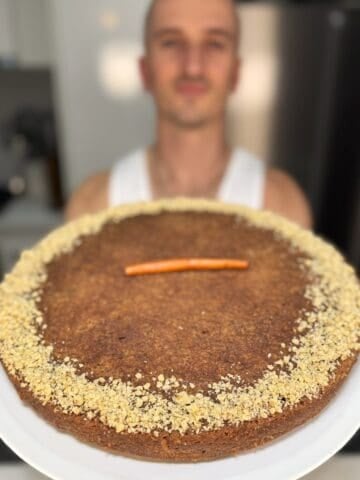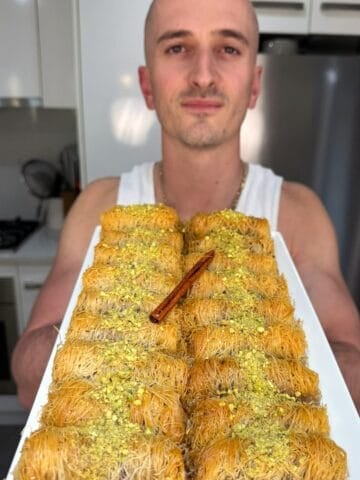This traditional Greek halva recipe is as easy as it gets, a rich and comforting semolina pudding cake that is warmly spiced and perfectly sweet. One of the easiest desserts you will ever make, no bake, no stress, and every bite melts in your mouth.

Greek semolina halva is a traditional dessert that is very popular during Lent, making it a go-to for anyone with a sweet tooth during fasting periods, but it is also enjoyed all year round.
If you love super easy dessert recipes and want to try something else, you should check out my mosaiko recipe, a no-bake Greek chocolate biscuit cake, or my easy Greek milk pie recipe, known as galatopita.
Jump to:
Why you will love this recipe
- So easy, no baking needed: This Greek halva cake is made right on the stove. No oven, no stress, just a few steps and you’re done.
- Smells unreal: The mix of cinnamon, cloves, and toasted nuts makes the whole kitchen smell amazing. You’ll want to eat it straight from the pot.
- Perfect texture: Soft and melts in your mouth but still firm enough to slice. The olive oil and semolina pudding combo makes it just right.
- No eggs or dairy: This dessert has no dairy products or eggs, and if you're following a vegan diet, you can easily swap the honey for more sugar.

My Big Fat Greek Wedding Throwback
I couldn’t resist sneaking in a quick My Big Fat Greek Wedding moment in my video. You know the scene, the famous bundt cake gift where they say, "There's a hole in this cake!"
And if you continue watching, you will see how they "fixed" it later with a flower in the middle. 🤣 Classic.
What is Greek halva?
The word halva, written in Greek as Χαλβάς (Halvás), generally refers to the Greek version of traditional halva, which is what we’re making in this recipe.
It follows the 1:2:3:4 method, a classic ratio used to give this Greek semolina cake the perfect texture and delicious taste. The numbers refer to the main ingredients:
- 1 part oil
- 2 parts semolina
- 3 parts sugar (including honey, if used)
- 4 parts water
We take this recipe up a notch by replacing part of the sugar with honey, and let me tell you, it makes such a beautiful difference in both flavour and aroma! If you’re interested, I’ve also covered a few other variations and substitutions down below.
Watch the short video tutorial
Want to see exactly how it’s done? Watch my step-by-step video on making this Greek semolina halva recipe from start to finish.
Make sure to like, comment, and share the video with someone who’d love to have a slice with you over a cup of Greek coffee.
Ingredients
Here's a breakdown of the simple ingredients you need to make this rich, nutty, and perfectly sweet traditional Greek dessert. As always, see the recipe card below for the exact quantities.

Syrup
- Water: This forms the base of the sugar syrup, giving the halva its signature soft yet slightly firm texture.
- Raw Sugar: Adds a deep, caramel-like sweetness. You can use white sugar, but raw sugar helps give the halva a warmer colour and richer flavour.
- Honey: This doesn’t just add extra sweetness, it gives the syrup a beautiful aroma when mixed with the warm spices. Since this recipe follows the 1:2:3:4 ratio, the honey is counted as part of the sugar to maintain the perfect balance.
- Ground Cinnamon & Cloves: These warm spices infuse the syrup with an irresistible smell, adding a comforting, cosy flavour that makes every bite better.
- Lemon Juice: A little bit of lemon juice balances the sweetness and enhances the syrup, making it taste a little brighter and fresher. If you do add the lemon peel, just make sure to remove it before using the syrup.
Semolina mixture
- Almonds: These add a nice crunch to the pudding! They’re coarsely chopped and lightly toasted before the semolina is added, bringing out their natural nuttiness.
- Olive Oil: This is what gives Greek halva its signature richness. A good-quality extra virgin olive oil will make a difference, trust me!
- Semolina: The key ingredient! I prefer using fine semolina for a smooth texture, especially since we’re adding almonds for a crunch. But if you like a bit more bite, you can mix in some coarse semolina for extra texture.
Garnish
- Ground Cinnamon: A light dusting of cinnamon powder on top enhances both the look and taste of the halva.
- Crushed Almonds: These don’t have to be toasted! Just crush a little extra when prepping your ingredients and set them aside. Feel free to swap them for your favourite nuts like walnuts, pistachios or pine nuts for a different twist.
Preparation
Even though this recipe is super fast and simple, here’s what to get sorted so everything goes as smoothly as possible.

- Crush your nuts: Add your whole almonds to a food processor and pulse them a few times. I like to keep a mix of large and small pieces for different textures.
- Prepare the garnish: If you’re copying me, once you’ve crushed the nuts for the semolina pudding, crush a little extra but go finer for the topping. Set it aside with some extra cinnamon and a small sift.
- Grease a bundt pan: I use a 24 cm diameter bundt pan. Try to find something similar for the best results. Use a pastry brush to apply a light coat of oil so the halva mixture doesn’t stick.
- Tools and equipment: You’ll need two pots, one for the semolina mixture and one for the syrup. Have a ladle ready to safely scoop the hot sugar syrup into the semolina mixture.
Step-by-step Instructions
Follow these steps to bring this Greek halva to life! I’ve included as many helpful images as possible, but if you need extra help, watch my video for detailed guidance and follow along as I walk you through the process.
Make the syrup

- Grab a deep pot or saucepan and add the water, raw sugar, cinnamon, cloves, and lemon juice. Then give it a quick stir to combine.
- Place the pot over medium-high heat and bring it to a rolling boil, making sure the sugar is fully dissolved.
- Turn off the heat, stir in the honey, then set the syrup aside while you get started on the semolina mixture.
Toast the nuts & semolina

- In another saucepan, toast the chopped almonds over medium heat, stirring constantly. You’ll know they’re ready when they turn slightly golden and smell nutty.
- Pour in the olive oil, then add the semolina to the saucepan as well.
- Keep stirring for a few minutes until the semolina turns light golden and gives off a warm, toasted aroma. Once it reaches that stage, turn off the heat.
Combine, shape & set

- Slowly pour the hot syrup into the semolina mixture, stirring non-stop. Be careful, as it will bubble and steam, so pour slowly to avoid splashes.
- Keep stirring until the halva mixture thickens up and starts pulling away from the sides of the pan.
- Lightly grease a bundt pan with olive oil, then spoon the mixture into it, pressing it down continuously to create a nice, even shape.
- Use a small spoon to press the mixture into the edges and corners of the pan, and smooth it out. Let it sit at room temperature to cool, then refrigerate for at least four hours until fully set.
- Note: The syrup must be hot when added to the semolina mixture. If it has cooled down too much, heat it back up before using it, otherwise, it won’t absorb properly. If your mixture isn’t coming together smoothly, keep stirring over medium-low heat to help it thicken evenly.
Garnish, slice & serve

- Place a serving plate on top of the bundt tin, then carefully flip it over. Give it a slight jiggle, and the halva will drop out.
- Using a small sift, dust the top with ground cinnamon, then sprinkle over the crushed nuts you set aside for garnish.
- Slice, serve, and enjoy with a cup of Greek coffee!
Variations
There are many different types of halva, as it’s made all around the world, each with its own unique ingredients and texture. But here are two unique versions you might find interesting, and one of them is another Greek variation.
- Tahini-Based Halva: Made from crushed sesame seeds (tahini), this version is popular throughout the Middle East and is also the base for Macedonian halva.
- Halva Farsalon: Another Greek version from Thessaly, although it is quite different from the traditional Greek semolina halva. Instead, it’s made with cornstarch, giving it a jelly-like texture.
Substitutions
- Oils & Butter: If you don’t want to use olive oil, you can swap it for sunflower oil or vegetable oil. Butter also works and gives the halva a richer, slightly creamier texture.
- Spices: Other spices that work well are allspice, cardamom, and vanilla. If you want a lighter-coloured halva, use a cinnamon stick in the syrup instead of ground cinnamon.
- Dried fruit: Some people like to add dried fruit such as raisins or sultanas instead of nuts. Since this cake is naturally sweet, I prefer nuts, but feel free to give it a go!
- Orange: If you don’t want to use lemon, you can swap it for orange peel in the syrup.
Storage
Store halva in an airtight container in the fridge for up to a week. Let it sit at room temperature for about 10 minutes before serving if you prefer a softer texture.








Emily Pontis says
For a “boring” cake, as my kids call it, they loved your version! Never made Halva with brown sugar and honey before, but it made it so much more caramel like, definitely makes a difference.
Nikolopaa says
Haha! Thanks so much Emily for your comment! If the kids loved it then thats a big win 🙂 Appreciate you making my recipe 🙏
Cleo Saad says
The halva didn't come out of the bunt tin so i had to scoop it out.
The texture of the halva wasn't correct. I asked my Aunt, whose an amazing cook, and she said that i should have continued cooking the semolina mixture as i slowly added the syrup. Further cooking would have reduced the liquid and solidified the mixture.
The taste wasn't great as i remembered Halva to be.
Nikolopaa says
Hey Cleo, sorry that it didn’t work out for you, scooping it out of the tin shouldn't be happening. I’ve made it exactly this way in the video and many times before and it works every time for me. Just curious, did you stir the semolina on the heat until it was toasty? Did you grease the tin before adding it in? And did you allow it to fully set like the recipe mentions?
Also, in regard to the taste, this recipe follows the traditional 1:2:3:4 ratio for Greek halva. Not everyone’s cup of tea but I didn’t want to deviate from the original ratios.
Hope this helps get it right if you give it another go! 🙏
Irene says
I love, love, love Halva and this recipe is very good. It is a bit too sweet for my liking so I may reduce the sweetness a bit next time (I used a combination of sugar-in-the-raw and honey).
Nikolopaa says
Thanks so much for the 5 stars Irene 🙂 Really glad you enjoyed it! I do agree it's on the sweeter side, and so many people think the same with the original 1:2:3:4 recipe haha. Feel free to dial it back a little next time. Appreciate you giving it a go! 🙏❤️
Sue says
This recipe turned out perfect. Thanks for the easy steps to follow and loved the short video showing the steps - very funny!
Nikolopaa says
Thanks for trying the recipe Sue! No worries 🙏 and glad you enjoy the humour in the video as well!